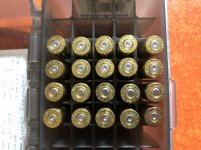Hey guys perhaps a little help. Next week my new Criterion 1-7T 223 barrel will arrive. So, I'm going to have to work up a brand new load. I'm interested in hearing how others go about doing this.
My thought was to first call Sierra and ask them if the bullet I intend to shoot prefers a particular jump. Once I have the jump determined load multiple rounds with the same CBTO length but different powder loads.
Monitor the FPS of the loads. Watch for a load that does not increase in speed and watch the ES. Once the powder drop is determined fine tune the load with changes in seating depth and or neck tension.
Would love to hear how you guys go about developing a new load for a new barrel.
My thought was to first call Sierra and ask them if the bullet I intend to shoot prefers a particular jump. Once I have the jump determined load multiple rounds with the same CBTO length but different powder loads.
Monitor the FPS of the loads. Watch for a load that does not increase in speed and watch the ES. Once the powder drop is determined fine tune the load with changes in seating depth and or neck tension.
Would love to hear how you guys go about developing a new load for a new barrel.

